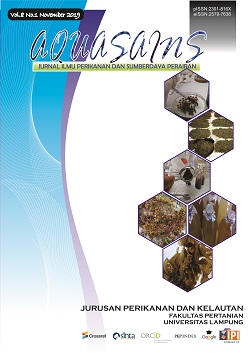EFFECT OF Avicennia sp. FRUIT EXTRACT IN PREVENTION OF THE SPREAD OF Vibrio parahaemolyticus BACTERIA IN VANAME SHRIMP (Litopenaeus vannamei)
DOI:
https://doi.org/10.23960/aqs.v8i1.p735-742 Abstract View: 601
Abstract View: 601
Abstract
Vaname shrimp (Litopenaeus vannamei) is one of the main aquaculture commodities in Indonesia because it has high economic value. But in the aquaculture it is known that there are diseases that cause death in shrimp before harvest time. Vibriosis is a disease caused by the Vibrio parahaemolyticus, bacteria which often attacks shrimp culture. Population control of Vibrio sp. done by giving immunostimulants and vaccines, as well as giving feed plus antibiotics. However, continuous use of antibiotics and improper doses will cause bacteria to become resistant and cause residues in the tissues. This study aims to examine the effect of Avicennia sp. fruit extract in preventing the infection of Vibrio parahae-molyticus in vaname shrimp on a laboratory scale. This study used the experimental method Complete Random Design (CRD), which consisted of five treatments with different concentrations of Avi-cennia sp. fruit extracts and three replications of individuals in the population. The results showed that Avicenniasp. fruit extract Avicennia sp. able to influence the inhibition of the growth of Vibrio parahaemolitycus bacteria and prevent the occurrence of vibriosis disease . This can be seen by the value of Relative Percent Survival (RPS) which is limitited to 50%, can slow down the time of death of the shrimp seen from the Mean Time to Death (MTD), and followed by a high Survival Rate (SR). The concentration that most affected the treatment was the concentration of 350 mg/l.
Keywords: Avicennia sp extract, vaname shrimp, Vibrio parahaemolyticus
.png)










